Texas Counties
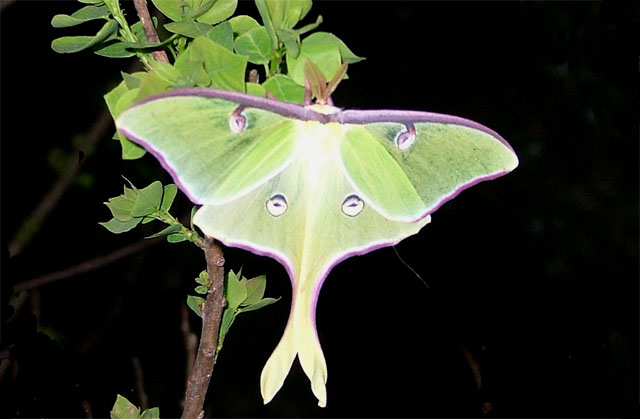
Actias luna, spring male (March 25, 2004), posed, courtesy of Robert Nuelle, III.

Actias luna, spring male (March 25, 2004), posed, courtesy of Robert Nuelle, III.
Actual ranges may, in many cases, be more expansive than noted. There are some species (Hemileuca hera, Dickens County) that may now be extirpated in some of the indicated counties.
Texas is a very large state, offering some varied habitats. Some species seem quite limited in their range and in most cases are listed below only beside that section of state where they may be found.
Anisota senatoria, A. stigma and A. virginiensis are only found in eastern counties while A. oslari is only found in the west.
Citheronia regalis, Dryocampa rubicunda and Sphingicampa bicolor and S. bisecta are also eastern species as are Eacles imperialis and Sphingicampa albolineata although these two species at least make it to center of state.
Sphingicampa blanchardi is found only in the extreme south with records for Cameron and Hildago counties.
Of the Automeris species, A. io is widespread; A. zephyria is western; A. louisiana is eastern.
Coloradia pandora davisi is limited to the extreme west.
Hemileuca oliviae is a northwestern species; Hemileuca juno is southwestern.
Clicking on a scientific name will take you to a file with pictures and/or information.
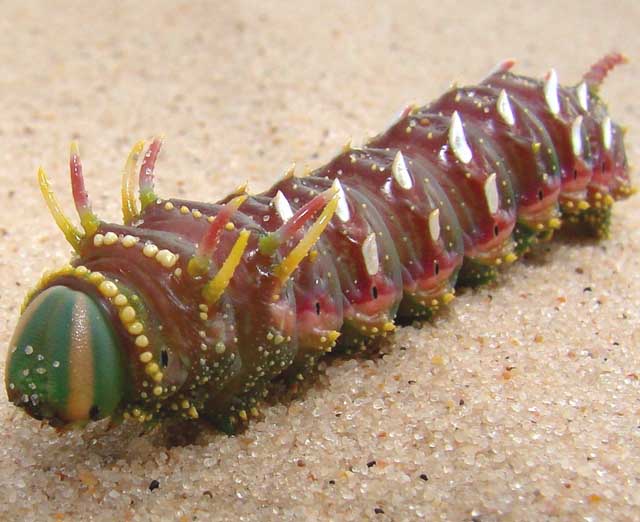
Syssphinx hubbardi/heiligbrodti, pre-pupal larva,
Monahans sand dunes, Texas,
October 12, 2007, courtesy of non-member Burr Williams.
I have placed the Syssphinx hubbardi symbol in Ward and Winkler counties, based on image above. It is also reported in southestern New Mexico just northwest of those two counties.
Dan reports a cecropia pairing in Crestwood Acres, southeast Bexar County, March 17, 2004.
I have added the Eacles imperialis
imperialis symbol to Bexar County, based on this prepupal larva image
sent to me by non-member Peter Melby, San Antonio, Bexar County. |
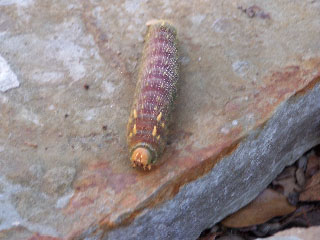 |
Mike van Buskirk writes, "I found several Hyalophora cecropia cocoons locally over the past winter in the Helotes area (Bexar County), and kept two, one which seemed to be a male, and a larger one I hoped might be a female.
"The male emerged on March 27th, but the other held over until Sunday April 13th. It was a female, and I put her out for a mate on the oak outside my front porch. No males from April 13-15th, and I was sure she would simply start laying infertile ova, but she continued to hold on to the oak trunk, so I left her alone.
"The nights on April 13-15 were cool-cold, clear, and with waxing moon--very few moths flying. Last evening April 16th was slightly warmer, overcast, and she had no mate when I left for work at 5:30am this morning (April 17th). However, when I returned from work at 5:30pm this afternoon, she indeed had a mate, a very fresh male! In my experience, the males fly to the females at the cusp of dawn, which would have been more towards 6:00am.
"The female has been sequestered for ova, and the male retained as a local voucher. It is the first H. cecropia I have seen in the vicinity of my home since moving to Grey Forest (near Helotes) in August 2005."

Hyalophora cecropia pair, Bexar County, Texas, April 17, 2008, courtesy of Mike van Buskirk.
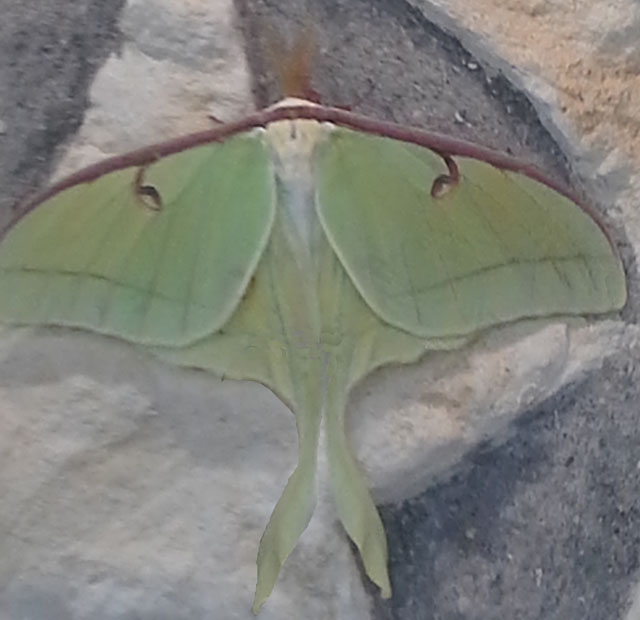
Actias luna male, Fredericksburg, Gillespie County, Texas,
September 1, 2014, courtesy of Greg Wassenich, digital repair by Bill Oehlke.
Visit Antheraea polyphemus mature larva, Forth Worth, Texas, October 23, 2009, courtesy of Phyllis.
Jeffrey Keverline writes, "I noticed that H. Cecropia wasn't indicated for Travis Co. on your county checklist for Central Texas. I found my first H. cecropia as cocoons at McKinney Falls State Park back in Jan. of 08. They were primarily found on Mexican plum, but I also saw several on Cornus drummondii and live oak that were all growing along a trail near the river that flows through the park. I also found two old cocoons on wax myrtle growing in my neighborhood in Northeast Austin.
I also found some 5th instar A. io caterpillars this last weekend (August 1, 2009) on Cornus drummondii and am rearing six of them."
Non-member Susan Singer sent me an image of an Antheraea polyphemus male on the side of an apartment in Nacogdoches, East Texas, on June 9, 2013.
Non-member Charlie Rogers reports a mature Eacles imperialis larva in Athens, Henderson County,
November 3, 2008.
Non-member Amy Peterson reports a mature Eacles imperialis larva in Austin, Travis County,
November 3, 2008.
Charles Bordelon writes, "I was looking at the Texas list last night. You can add Callosamia angulifera. A couple were taken by Hugo Kons and Bob Borth in Cass Co., Atlanta SP on 8 May, 2004. We are hoping to get one of the specimens some day, or collect our own."
Robert J. Nuelle reports Antherea polyphemus, Actias luna, Anisota stigma, Eacles imperialis, Automeris io, Citheronia regalis and Dryocampa rubicunda at lights in Angelina National Forest in Angelina County, August 23, 2003.
Andrew Spicer reports H. cecropia from Bastrop County and indicates he has not seen H.cecropia or C. regalis in Harris County for many years. Jean Keller reports Automeris io from eastern Tarrant County.
Joe McKoy reports, "I can report Actias luna from Hays county, and A. polyphemus from Travis County. I confirm H. cecropia from Bastrop County."
Ronda Farmer reports Actias luna adult in Waco (Maclennan County), September 22, 2003
Rita Cinquemani confirms Antheraea polyphemus in Harris County (Houston Area) with mature larval image, October 17, 2003.
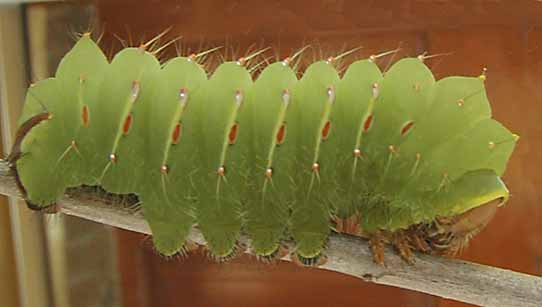
Antheraea polyphemus, (feeding on oak), courtesy of Rita Cinquemani.
Bob Weast, via records from
John Jackman, at TAMU confirms Actias luna in the following
counties:
Bexar, Comal, Harrison, Kendall, Uvalde, Wharton +,
Smith +, Robertson +, Kerr, Montgomery, Tyler,
Walker, Brazos, Grimes +, Anderson +, Leon +, Williamson +,
Wood + and Hays.
"+" follows counties whose records have been updated
on the map, January 2004. Bob Weast, via records from
John Jackman at TAMU, confirms Antheraea polyphemus in the
following counties:
Bastrop +, Bee, Bexar, Frio, Harris, Kerr, Mason, Brazon, Erath +,
Rusk +, Live Oak +, Washington +, Williamson + and Grimes +.
"+" follows counties whose records have been updated
on the map, January 2004. Bob Weast, via records from
John Jackman at TAMU, confirms Antheraea oculea in the
following counties: Culbertson + and Jeff Davis and in
Chiapas, Mexico; Tamalipas, Mexico; and Neuvo Leone, Mexico.
John & Susan Beree report Eupackardia calleta
for Arkansas County with image of larva on Cenizoa,
November 28, 2003. Stinkbug is waiting for a tender meal.
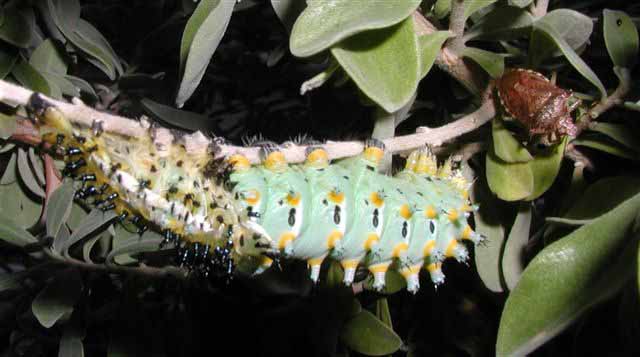
Tobias Ingram reports Hyalophora cecropia on the wing, March 10, 2004 in Bastrop County, near Travis County line.
Robert Nuelle reports Actias luna and Antheraea polyphemus are flying in Houston area in Harris County, March 10, 2004.
Ted C. Engel reports Hyalophora cecropia adults in La Grange, Texas, (Fayette County), March 17, 1997-2004. Larvae are reported on Cherry laurel, (Prunus laurocerasus).
Robert J. Nuell reports March 25, 2004, many Actias luna starting at 8:04 pm, two female Callosamia promethea, Antheraea polyphemus 10:30 pm and a few Dryocampa rubicunda in Huntsville, Texas (Walker County).
Joe McKoy reports, March 25, 2004, Actias luna from Lampasas County and many very large Hyalophora cecropia flying in Bexar County, same date.
Robert J. Nuell reports April 3, 2004, from Huntsville, Texas
(Walker County)
6:15 PM Callosamia promethea 1 – 2 males flying in the power cut.
7:33 PM Actias luna male – female (over 100 in total next
5 hours)
7:50 PM Callosamia promethea 1 Female (very small)
9:30 PM Antheraea polyphemus 4 Males in total for night
9:35 PM Dryocampa rubicunda
10:56 PM Antheraea polyphemus males
11:15 PM Automeris io male (not fresh)
Rick Illingworth reports Anisota stigma, Antheraea polyphemus,
Automeris io from Keene, Johnson County.
Rick reports pairing of Antheraea polyphemus, August 14, 2008, and pairings of wild
Actias luna males with caged females on September 7, 2008.
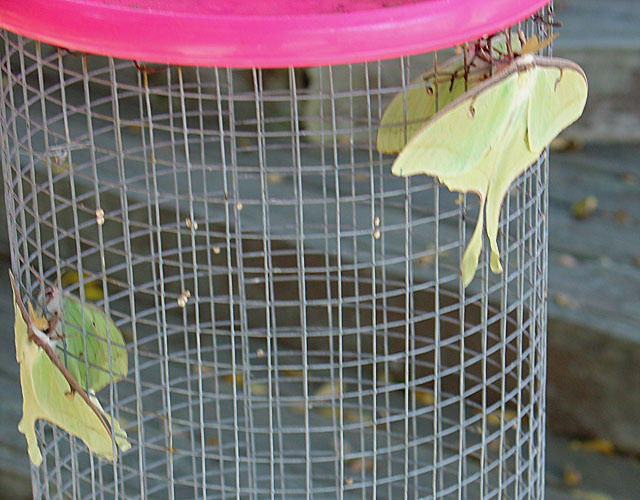
Actias luna pairings, Johnson County, Texas, September 7, 2008, courtesy of Enrique (Rick) Illingworth.
Non-member Claire Currie confirms
Actias luna, March 22, 2005, and Antheraea polyphemus,
August 25, 2002, from Wise County with images.
She also shows Hemaris thysbe from both Montague and
Wise counties in September, Hemaris diffinis from Wise County,
June 10 and August 29. Xylophanes tersa larva from
Wise County, August 21, and Hyles lineata adult,
September 1, 2004, Wise County.
Eggs were collected and larvae were reared on various Quercus
species. Moths began emerging on November 24, 2005.
Larvae were greener and moths browner than the nominate subspecies
A. virginiensis seen further north and east, suggesting
subspecies Anisota virginiensis discolor, which Tuskes, Tuttle
and Collins, probably properly regard as a regional/clinal
variation (colour morph) of Anisota virginiensis virginiensis
rather than as a distinct subspecies.
Robert J. Nuelle reports Hemileuca peigleri from Calhoun County, December 26, 2005.
Matt Curtis recalls H. cecropia, A. luna, A. polyphemus and C. regalis from his boyhood haunts in Grayson County, in the 1950'5-1960's.
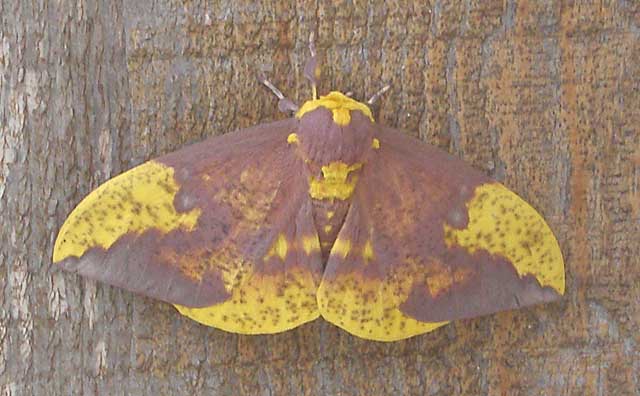
Eacles imperialis, May 8, 2007, Austin, Travis Co., Texas, courtesy of Kevin Sprague.
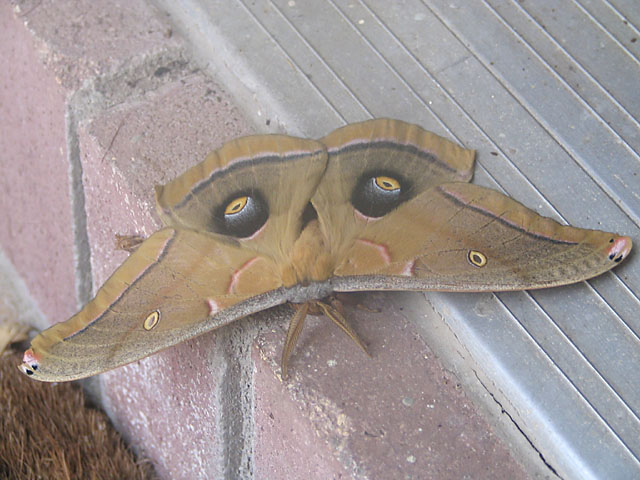
Antheraea polyphemus, September 15, 2007, Austin,
Travis Co., Texas,
courtesy of Claudia Machell.
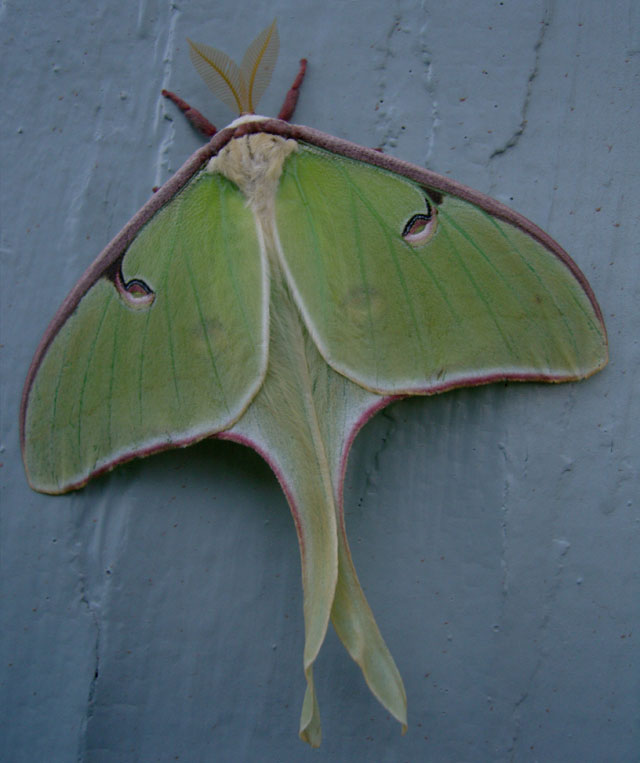
Actias luna male, Dewitt County, Texas, March 23, 2008, courtesy of Michael Vandeveer.
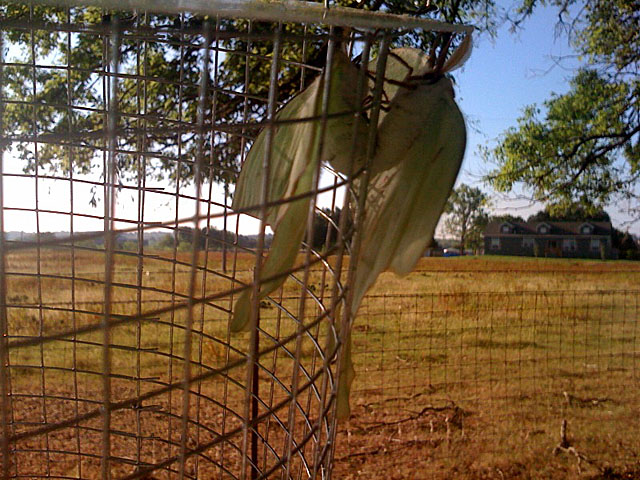
Visit Eacles imperialis mature larva, The Woodlands, Montgomery County, Texas, November 2, 2009, courtesy of Sophie and Ellie Johnson. Care of found mature larvae is also described on this page. Non-member Sharon Frels confirms Eacles imperialis in Guadalupe County, September 4, 2010.
Return to Texas List
Goto to Main Index
Visit Texas Sphingidae
Visit Texas Catocala